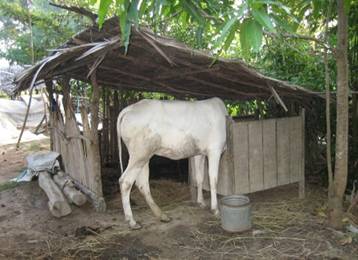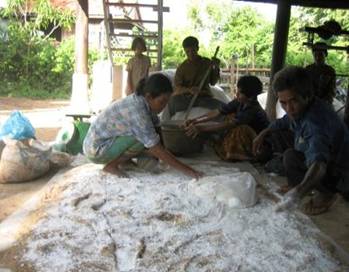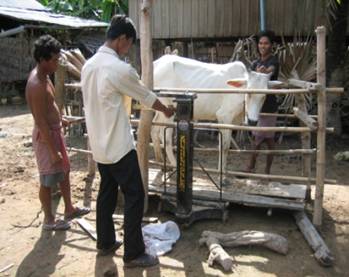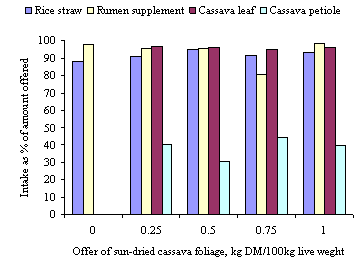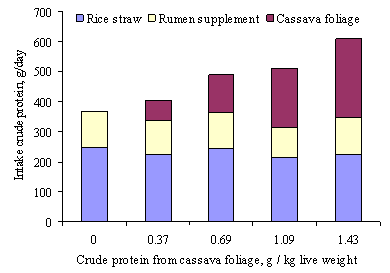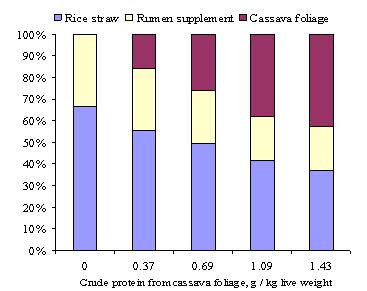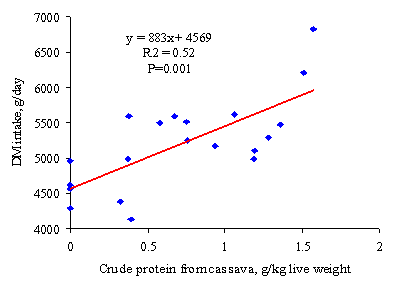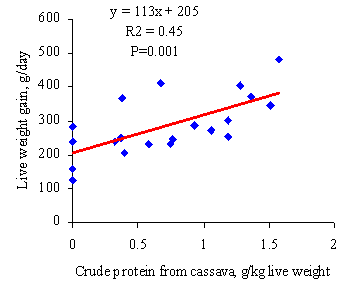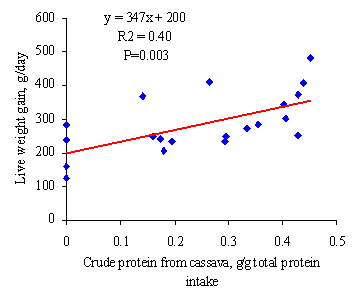Effect of levels of sun-dried cassava foliage on
growth performance of cattle fed rice straw
Keo Sath, Khieu Borin and T R Preston*
CelAgrid, Cambodia
keosath@celagrid.org
*Finca Ecológica,UTA-Colombia, AA#48, Socorro,
Santander, Colombia
Abstract
An on-farm trial experiment was carried out in Treang district,
Takeo province from June to September 2006. Twenty female cattle
were allocated to five levels of sun-dried cassava foliage (0,
0.25, 0.5, 0.75 and 1 % of body weight in DM basis) to evaluate the
growth response when fed a basal diet of untreated rice straw plus
a rumen supplement. The heifers were tethered alongside the feed
trough in each household, where they had free access to the
experimental diet and water. The heifers were provided rumen
supplement (mainly urea, sulphur and other minerals) at 0.25% body
weight and ad libitum rice straw. The design was a
completely randomized design (CRD) with four replications of each
treatment.
The intake of the leaf component of the cassava was 90% of the
offer but only 45% of the offer level of petiole was consumed. The
total intake of DM and crude protein intake increased according to
the intake of cassava foliage. Daily weight gain increased from 201
to 402 g/day and feed conversion was better with increasing levels
of protein from sun-dried cassava foliage in the diet. The
responses were linear over the range of cassava crude protein
intakes from 0 to 1.6 g/kg live weight.
It is concluded that supplementation with sun dried cassava
foliage stimulated the growth performance of cattle and that the
response was linear over the range from 0 to 1.6g cassava crude
protein/kg live weight.
Key words: On-farm trial, Sun-dried cassava
foliage, rumen supplement, rice straw, growth response cattle,
intake
Introduction
Similar with other developing countries in the region, large
ruminants in Cambodia depend on natural pasture and crop residues,
mainly rice straw. These are of low digestibility and usually
imbalanced in essential nutrients which contribute to low feed
intake (Schiere and Ibrahim 1989). Supplements are required to
improve rumen microbial fermentation and therefore the performance
of the host animals (Dixon and Egan 1987). Inadequate nutrition in
cattle has often caused economic loss to the farmers because their
animals loose weight and body condition, resulting in reduced
reproductive capacity and increased susceptibility to diseases and
parasites (Leng 1997).
Early work with fresh cassava leaves showed that it could be the
sole source of supplementary protein and roughage in diets for
fattening cattle based on liquid molasses-urea (Ffoulkes and
Preston 1978). When used as a supplement to untreated rice straw
the growth rates in 'local "yellow" cattle were increased threefold
by supplementing them with fresh cassava foliage (Seng Mom et al 2001). Ho Quang Do et
al (2002) reported a curvilinear increase in
N retention in goats when fresh cassava leaves replaced grass as
the supplement to ammoniated rice straw.
In Cambodia, cassava (Manihot esculenta) is usually
planted by the farmers with the main purpose of root harvesting and
the leaves are left in the field. It has been shown that this
residue can be a valuable source of protein for feeding to many
kinds of animals (Preston 2001). When farmers harvest cassava
root, the leaves are still a good quality protein feed for cattle
particularly in the dry season. This situation can give an
opportunity for farmers to get more benefit by collecting the
cassava leaves for cattle feeding. Therefore, it is important to
promote ways of maximizing the use of this valuable crop. Wanapat
et al (1997) have drawn attention to the potential of cassava
foliage made into hay, which combined leaves, stems and petiole, as
a feed for ruminants. Added to this, cassava foliage contains
condensed tannins (Wanapat et al 1997), which when fed to
buffaloes in form of sun dried hay (Netpana et al 2001; Granum et al 2002) and goats (Seng sokerya and Preston
2003) in fresh form
has been reported to reduce nematode egg counts.
In view of the potential of cassava foliage as a supplement for
ruminant animals, there is a need to promote research with this
feed for cattle in the Cambodia situation.
Objectives
-
To study effect of levels of sun dried cassava foliage on growth performance of cattle fed rice straw
-
To study effect of sun dried cassava foliage on faecal nematode egg counts
-
To introduce to farmers the idea of using cassava foliage for their animals
Materials and Methods
Location and duration
The experiment was carried out in villages in Treang district,
Takeo province which is about 80 km south of Phnom Penh city. The
experiment was conducted for 3 months from June to September, 2006
excluding adaptation and organizing period.
Farmer selection
In Treang district, Takeo provice, CelAgrid has been
implementing a cattle project financed by Heifer International
Cambodia. The aims of the implementation are to improve cattle
management and feeding. Twenty farmers (including women
householders) were selected for the study to evaluate the response
to sun-dried cassava foliage. Beside these farmers, seven other
farmers joined in the study to serve as controls using the
traditional system of un-supplemented free grazing treatment. The
selection of the farmers was based on:
-
Having Heifers of 1.5 to 2 years of age
-
Availability of land for growing cassava foliage
-
Willingness to participate in the research and strong commitment to the idea
-
Willingness to share technologies with neighbors
Experimental design
The experimental design was a "production function" to evaluate
the growth response of cattle to increasing levels of sun-dried
cassava foliage when fed untreated rice straw plus a "rumen
supplement". One female animal per household (n=20) was allocated
to one of 5 levels of sun dried cassava foliage (0, 0.25, 0.5, 0.75
and 1 % of body weight in DM basis). The design was a completely
randomized design (CRD) with 4 replications of each treatment.
The individual treatments were
- RC0: Rice straw + rumen supplement at 0.25%
body weight
- RC0.25: Rice straw + rumen supplement 0.25% body
weight + sun dried cassava foliage 0.25% body weight (in
DM)
- RC0.50: Rice straw + rumen supplement 0.25% body
weight + sun dried cassava foliage 0.50% body weight (in
DM)
- RC0.75: Rice straw + rumen supplement 0.25% body
weight + sun dried cassava foliage 0.75% body weight (in
DM)
- RC1: Rice straw + rumen supplement 0.25%
body weight + sun dried cassava foliage 1% body weight (in
DM)
Animals and management
The heifers were vaccinated against Foot and Mouth Disease
before starting the experiment. They were from 1.5 to 2 years of
age with an average live weight of 174 kg live weight. Twenty
heifers were tethered alongside the feed trough (Photo 1) in each
household, where they had free access to the experimental diet.
The sun-died cassava foliage was fed first at about 7.00 am. The
rumen supplement and rice straw were fed 2 times per day in the
morning (8:00h) and afternoon (16:00h). Water was available the
whole day. The seven "control" heifers were kept under traditional
farmer management of free grazing and no
supplementation.
|
|
|
Photo 1: Individual animals tethered to the feed trough
in each household |
Experimental Feeding
The cassava foliage was bought from farm households situated
along the riverside in Kandal province, at the time of harvesting
the roots. It was taken to CelAgrid for drying. The cassava leaves
plus petioles were separated from the hard stem and sun dried by
spreading on a plastic sheet placed on the ground. The duration of
sun drying was 3 to 5 days until the leaves become crisp
(>85%DM). After sun drying, the foliages were stored in bags and
transported to the study site in Takeo province.
The ingredients for the rumen supplement (Table 1) were bought at the local market and mixed by the farmers participating in the study (Photo 2). After mixing, it was kept by each farm household and fed to the cattle at the rate of 0.25% of body weight per day. Rice straw was bought from farmers in the study area. It was from rice grown under rain-fed conditions.
|
Table 1: Composition of the rumen supplement |
|
|
Ingredient |
% (fresh basis) |
|
Sugar palm syrup |
27 |
|
Water |
13 |
|
Rice bran |
33.5 |
|
Urea |
13 |
|
Diammonium phosphate |
3 |
|
Salt |
5 |
|
Lime |
5 |
|
Sulfur |
0.5 |
|
|
|
Photo 2: Farmers preparing the rumen supplement
|
Data collection
Feeds offered and refused were recorded daily and weighed to
measure daily feed intake. Representative samples of feeds offered
and refused were collected for chemical analysis. The live weight
was taken at the beginning of the study and then every 2 weeks
until the end of the trial (Photo 3). Faecal samples were collected
directly from the rectum of each animal once at the beginning of
the experiment and after every 2 week interval to check the
nematode egg count.
|
|
|
Photo 3: the method of weighing the cattle |
Chemical analyses
The feeds offered and refused were analyzed for DM using
microwave radiation (Undersander et al 1993) and N following the Kjeldahl procedure as outlined by AOAC (1990). For faecal egg
counts, 4 g of representative samples of faeces were ground and
mixed with 56 ml of floatation fluid (a saturated salt solution in
water). A sub sample was transferred to both compartments of a
McMaster counting chamber and allowed to stand for 5 minutes. All
helminth eggs were counted under a microscope at 10x10
magnification and multiplied by 50 to yield the eggs per gram of
faeces (Hansen and Perry 1994).
Statistical analysis
Data for feed intake, growth and feed conversion were analyzed
by analysis of variance (ANOVA) using the General Linear Model
procedure of MINITAB software (Version 13.31 2000). Sources of
variation were levels of sun dried cassava foliage and error.
Regression analysis was used to relate the independent variable
(levels sun dried cassava foliage) with the dependent variables
(live weight gain, feed intake and feed conversion).
Results and discussion
Animal health
There were no signs or symptoms of disease or toxicity in the
animals during the experiment. Animals were in good healthy and it
was observed that the skin became brighter in colour towards the
end of the experiment, especially in the treatments with highest
offer levels of cassava foliage. The changing appearance of the
skin observed in this study may have been due to the effect of the
protein supplementation enhancing the expression of immunity
against internal and external parasite (Leng R A. personal
communication).
Chemical composition of diet
The chemical composition of the components of the sun-dried cassava foliage, and of the rumen supplement, are shown in tables 2 and 3. The crude protein level in the cassava leaves was almost three times higher in the leaves than in the petioles. It was lower than in the studies of Wanapat (2003) and Vongsamphanh and Wanapat (2004) where the values reported were 23.6% and 27.3% in DM. These higher values could be because these authors harvested the foliage 3 months after planting, whereas the sun-dried cassava foliage in this study was collected at root harvesting. The nutritive value of cassava foliage has been shown to be affected by variety, location, soil type and other environmental conditions as well as the method of chemical analysis (Seerley 1972).
|
Table 2: Mean values for chemical composition of feed ingredients |
||
|
|
% DM |
N*6.25, % in DM |
|
Whole sun dried cassava foliage |
87 |
18.8 |
|
Sun dried cassava leaves |
88.7 |
23.4 |
|
Sun dried cassava petiole |
86.3 |
9.7 |
|
Rumen supplement |
70.6 |
39.6 |
The DM and crude protein of the rice straw varied slightly among the different households (Table 3). The mean overall values were 87.1% DM and 5.41% crude protein.
|
Table 3: Mean values for chemical composition of rice straw in the different house-holds |
||
|
Family name |
% DM |
N*6.25, % (in DM) |
|
Mr. Banh Keo |
85.6 |
5.8 |
|
Mr. Chham Kosal |
85.5 |
4.9 |
|
Mrs. Eth Sarom |
87.5 |
5.1 |
|
Mr. Im Ean |
88.0 |
5.1 |
|
Mr. Khat Youn |
88.3 |
4.9 |
|
Mr. Kim Cho |
86.3 |
5.7 |
|
Mr. Kong Thol |
87.5 |
4.9 |
|
Mr. Moa Khon |
88.4 |
5.7 |
|
Mrs. Moa Yat |
85.7 |
5.8 |
|
Mr. Ngan Thy |
85.8 |
5.7 |
|
Mrs. Nhem That |
86.3 |
5.7 |
|
Mrs. Nhem Theoun |
87.3 |
5.7 |
|
Mr. Ni Chivo |
87.5 |
4.9 |
|
Mrs. Oam Rani |
86.6 |
4.9 |
|
Mrs. Om Yen |
88.0 |
5.1 |
|
Mrs. Sok Chanthy |
88.0 |
5.8 |
|
Mrs. Sok Mali |
88.3 |
5.1 |
|
Mrs. Sok Min |
85.9 |
5.8 |
|
Mrs. Thou Ka |
86.8 |
5.8 |
|
Mrs. Yong Thuch |
87.8 |
5.7 |
|
Mean±SD |
87.1±1.01 |
5.41±0.39 |
Feed intake
The actual intake of the supplements was lower than the planned offer levels (Table 4; Figure 1). The heifers selected the cassava leaves in preference to the petioles, such that intakes of the former were 90% of the offer levels while for the latter it was less than 45% of offer levels. The low acceptability of the sun-dried petioles may be due to the effect of drying (rather hard in texture) or the lower protein content. In this study, leaves and petioles were sun-dried without chopping. In contrast, when feeding fresh cassava foliage managed by repeated harvesting there was no selection (personal observation) against the petioles. The cattle consumed petioles, leaves and soft stems but refused the hard stems.
|
Table 4: Actual intake of sun dried cassava foliage compared with planned levels |
|||||
|
Planned, % of body weight (DM) |
0 |
0.25 |
0.5 |
0.75 |
1 |
|
Actual intake,% body weight (DM) |
0 |
0.18 |
0.34 |
0.55 |
0.73 |
|
Intake as % amount offered |
|
|
|||
|
Cassava leaf |
0 |
96.7 |
95.7 |
94.9 |
96.0 |
|
Cassava petiole |
0 |
40.1 |
30.3 |
44.2 |
39.4 |
|
Cassava crude protein, g/g total CP in diet |
0 |
0.16 |
0.26 |
0.38 |
0.43 |
|
|
|
Figure 1: Mean values for intake of diet ingredients as % of amount offered according to the offer level of sun-dried cassava foliage |
There were no significant effects of cassava foliage intake on DM and crude protein intake of rice straw and rumen supplement (Table 5). However, total intake of DM and crude protein intake increased according to the intake of cassava foliage (Figures 2 and 3). The total DM increased by 30% and the crude protein by 65% at the highest level of cassava foliage. The proportion of dietary crude protein from sun dried cassava foliage was 40% of the total crude protein intake at the highest level of supplementation (Figure 4). The effect of the sun-dried cassava foliage in increasing the total DM intake in this study is in agreement with reports by Vongsamphanh and Wanapat (2004), who supplemented rice straw with cassava hay in a study with cattle, and by by Ho Quang Do et al (2002) who supplemented fresh cassava foliage to goats fed ammoniated rice straw. The positive linear trend in total DM intake in response to the supplementary cassava foliage protein (Figure 5) is in accordance with the thesis outlined by Leng and Preston (1976) and by IAEA (2002) that the selected protein supplement should not reduce intake and utilization of the basal diet but instead have potential to enhance them.
|
Table 5: Mean values for feed intake and crude protein intake of heifers fed rice straw with levels of sun dried cassava foliage |
||||||||
|
|
Planned levels of cassava, % of live weight (DM basis) |
|||||||
|
|
0 |
0.25 |
0.5 |
0.75 |
1 |
SEM |
P |
|
|
DM intake, g/day |
|
|
|
|
|
|
||
|
Rice straw |
4295 |
4156 |
4538 |
3967 |
4336 |
224 |
0.49 |
|
|
Rumen supplement |
315 |
293 |
303 |
258 |
309 |
18.5 |
0.26 |
|
|
Cassava |
0 |
323 |
621 |
994 |
1305 |
|
|
|
|
Total |
4609c |
4772c |
5462bc |
5219bc |
5950ab |
234 |
0.001 |
|
|
DMI, g/kg LW |
25.6 |
27.0 |
30.1 |
29.2 |
32.8 |
1.97 |
0.14 |
|
|
CP intake, g/day |
|
|
|
|
|
|||
|
Rice straw |
245 |
223 |
243 |
213 |
224 |
16.7 |
0.62 |
|
|
Rumen supplement |
125 |
116 |
120 |
102 |
122 |
7.32 |
0.26 |
|
|
Cassava |
0 |
64.7 |
127 |
196 |
261 |
|
|
|
|
Total |
369d |
404cd |
490bc |
511b |
608a |
20.8 |
0.001 |
|
|
|
|
Figure 2: Mean values for intake of diet ingredients according to intake of crude protein from sun-dried cassava foliage |
|
|
|
Figure 3: Mean values for intake of crude protein from the different dietary ingredients according to intake of intake of crude protein from sun-dried cassava foliage |
|
|
|
Figure 4: Mean values for percentage of dietary crude intake from the different ingredients according to intake of crude protein from sun-dried cassava foliage |
|
|
|
Figure 5: Relationship between sun-dried cassava foliage intake and DM intake |
Growth rate
There were major differences in live weight gain between the heifers fed rice straw and rumen supplement (without cassava foliage) and those on un-supplemented free grazing (Figure 6). The rumen supplement provided nutrients for rumen microbes (ammonia, sulphur, phosphorus and other minerals) that can correct deficiencies of these nutrients in poor quality feeds such as rice straw. It cannot be concluded that the difference was due only to the rumen supplement as the grazing areas were extremely limited due to the land being used for the rice crop. The daily weight gain of the cattle fed only rumen supplement and straw in this experiment was higher than in the study of Seng Mom et al (2001); however, there were differences in the breeds which were larger and of Zebu type in our study compared with the smaller "Yellow" breed of cattle used by Seng Mom et al (2001).
|
|
|
Figure 6: Comparison of rice straw + rumen supplement (without cassava) and free grazing on live weight gain |
Daily weight gain increased and feed conversion was better with
increasing levels of protein from sun-dried cassava foliage in the
diet (Table 6). The responses (Figures 7 and 8) were linear over
the range of cassava crude protein intakes recorded in the
experiment (from 0 to 1.6 g crude protein/kg live weight). The
improved growth rates and feed conversion in this study are in
agreement with the reports of Seng Mom et al (2001) and Ho Quang
Do et al (2001), who used fresh cassava foliage as a supplement
for cattle fed rice straw and Moore, (1976) who gave cassava
foliage to steers fed Pennisetum purpureum with varying
levels of cassava foliage. Le Huu Khoung and Duong Nguyen Khang
(2005) reported a linear increase in live weight gain in "Sindhi*
Yellow" cattle fed fresh cassava foliage as a supplement to
urea-treated rice straw. The maximum response of 60% was less than
the 200% response in our study probably because the rate of cassava
foliage supplementation was higher (1.6 g/kg live weight compared
with 1.0 g/kg live weight in the study of Le Huu Khoung and Duong
Nguyen Khang (2005). The response in the experiment of Seng Mom et
al (2001) was 400% for cassava foliage protein at 1.3 g/kg live
weight compared with the control.
The results of this study, together with the numerous reports in the literature, indicate strongly that the beneficial effect in ruminants of the protein in cassava foliage is due to its " bypass" or " escape'' properties presumably because of the binding effect on the protein of the tannins present in this forage (Wanapat et al 1997). In an in vitro study, Promkot and Wanapat (2003) estimated that the rumen undegradable protein (assumed to be bypass protein) as percent of total protein in cassava hay was 52.7 compared with 50.4 for cottonseed meal (considered to be one of the best sources of bypass protein according to Preston and Leng 1987) and 35 for leucaena leaf meal
|
Table 6: Mean values for live weight and conversion of heifers fed rice straw with levels of sun dried cassava foliage |
||||||||
|
|
Planned levels of cassava, % of live weight (DM basis) |
|||||||
|
|
0 |
0.25 |
0.5 |
0.75 |
1 |
SEM |
P |
|
|
Live weight, kg |
|
|
|
|
|
|
||
|
Initial |
175 |
166 |
170 |
168 |
166 |
8.88 |
0.93 |
|
|
Final |
191 |
189 |
196 |
192 |
199 |
9.24 |
0.93 |
|
|
Final# |
185 |
192 |
195 |
193 |
202 |
3.50 |
0.058 |
|
|
Daily gain, g/day |
201b |
266ab |
282ab |
278ab |
402a |
33.0 |
0.01 |
|
|
Feed DM conversion |
25.1 |
18.4 |
20. |
18.8 |
15.0 |
2.39 |
0.09 |
|
|
# Adjusted for differences in initial weight |
||||||||
|
|
|
Figure 7: Relationship between protein from sun-dried cassava foliage intake (as g/kg live weight) and live weight gain |
|
|
|
Figure 8: Relationship between protein from sun-dried cassava foliage (as proportion of total crude protein intake) and live weight gain |
|
|
|
Figure 9: Relationship between intake of crude protein from sun-dried cassava foliage and DM feed conversion |
Parasite egg count
The numbers of nematode eggs in the faeces were extremely low both in the supplemented cattle and those on free grazing with no obvious tendencies due to date of sampling or supplementation (Table 7).
|
Table 7: Nematode egg counts/g of faeces in the heifers fed rice straw and sun-dried cassava foliage or on free grazing |
||||||
|
Sample date |
Crude protein from cassava foliage, g/kg live weight |
Free grazing |
||||
|
0 |
0.37 |
0.69 |
1.09 |
1.43 |
||
|
6/27/2006 |
275 |
188 |
238 |
200 |
425 |
243 |
|
7/11/2006 |
138 |
150 |
225 |
150 |
188 |
143 |
|
7/25/2006 |
238 |
250 |
275 |
375 |
175 |
193 |
|
8/8/2006 |
150 |
125 |
466 |
213 |
225 |
171 |
|
8/22/2006 |
213 |
100 |
325 |
163 |
288 |
171 |
|
9/5/2006 |
163 |
88 |
225 |
88 |
150 |
179 |
|
9/19/2006 |
200 |
75 |
138 |
100 |
163 |
229 |
Conclusions
Based on the results of this research it is
concluded that:
-
Increasing levels of sun dried cassava foliage led to significant increases in total dry matter intake and daily weight gain of cattle fed untreated rice straw and a rumen supplement
-
The response to cassava foliage protein in cattle fed untreated rice straw and rumen supplement is linear over the range of 0 to 1.6 g crude protein/kg live weight.
-
Sun dried cassava foliage is a good source of bypass protein source for cattle
Acknowledgements
The authors are grateful to the MEKARN project, financed by the
Sida-SAREC agency and my assistants Mr. Pek Samnang and Chea
Chheangly for their technical help. Thanks are also due to 27
farmers in Treang District, Takeo province, who shared their
experiences and participated actively in this study.
References
AOAC 1990 Official Method of Analysis. Association of
Official Analytical Chemists. 15th edition (K Helrick
editor). Arlington pp 1230
Dixon R M and Egan A R 1987 Strategies for utilization
fibrous crop residues as animal feeds, Paper presented to the
7th AAFARR workshop, Chaing Mai, Thailand
Ffoulkes D and Preston T R 1978Cassava or sweet potato
forage as combined sources of protein and roughage in molasses
based diets: effect of supplementation with soybean meal Tropical
Animal Production (3): 186-192
Granum G, Wanapat M, Wachirapakorn C and Pakdee P 2002
The effect of cassava hay supplementation on weight change, dry
matter intake, digestibility and internal parasites in swamp
buffaloes (bubalus bubalis) and cattle (bos indicus).
In: Proc. Agriculture Conference, Narasuan University,
Pitsanuloke, Thailand, July 26-30.
Hansen Jørgen and Perry Brian 1994 The epidemiology
diagnosis and control of helminth parasites of ruminants. A
Handbook, International Laboratory for Research on Animal Diseases,
Nairobi, Kenya
Ho Quang Do, Vo Van San and Preston T R 2001 Blocks or
cakes of urea-molasses as supplement for Sindhi x Yellow cattle fed
rice straw and cut grass or cassava foliage. In: Proc.
International Workshop on Current Research and Development on Use
of Cassava as Animal feed. (Eds, T R Preston, B Ogle and M
Wanapat), organized by Khon Kaen University and SIDA-SAREC, Sweden.
July 23-24, 2001
Ho Quang Do, Vo Van Son, Bui Phan Thu Hang, Vuong Chan Tri
and Preston T R 2002 Effect of supplementation of ammoniated
rice straw with cassava leaves or grass on intake, digestibility
and N retention by goats. Livestock Research for Rural Development
(14) 3: http://www.cipav.org.co/lrrd/lrrd14/3/do143b.htm
IAEA 2002Development and Field Evaluation of Animal feed
supplementation Packages. Proceeding of the final review meeting of
an IAEA Technical co-operation regional AFRA project. Vienna 2002
IAEA
Le Huu Khoung and Duong Nguyen Khang 2005 Effect of fresh
foliage on growth and faecal nematode egg counts in Sindhi X Yellow
cattle fed urea-treated rice straw basal diet. In: Proc. Regional
seminar workshop on livestock based sustainable farming systems in
the lower Mekong Basin. (Eds, T R Preston, B Ogle) organized by
Cantho University, Vietnam and Sida-SAREC, Sweden. May 23-25, 2005
Leng R A 1997 Tree foliage in ruminant nutrition.
http://www.fao.org/docrep/003/w7448e/w7448e00.htm
Leng R A and Preston T R 1976 Sugarcane for cattle
production: present constraints, perspectives and
researchpriorities. Tropical Animal Production 1:
1-22
Netpana N, Wanapat M, Poungchompu O and Toburan W 2001
Effect of condensed tannins in cassava hay on fecal parasitic egg
counts in swamp buffaloes and cattle. In: Proceedings International
Workshop on Current Research and Development on Use of Cassava as
Animal Feed. T R Preston, B Ogle and M Wanapat (Ed) http://www.mekarn.org/procKK/netp.htm
Moore C P 1976 The utilization of cassava forage
in ruminant feeding. International Seminar on Tropical Livestock
Products, 8-12 March, Acapulco, Mexico.
PrestonT R 2001 Potential of cassava in integrated
faming systems. In: Proc. International Workshop on Current
Research and Development on Use of Cassava as Animal feed. (Eds, T
R Preston, B Ogle and M Wanapat), organized by Khon Kaen University
and SIDA-SAREC, Sweden. July 23-24, 2001
Preston T R and Leng R A 1987 Matching Ruminant
Production System with Available Resource in the Tropic and
Subtropics. PENAMBUL BOOKS: ARMIDALE, P.O.Box 512, Armidale, New
South Wales 2350, Australia.
Promkot C and Wanapat M 2993 Ruminal degradation and
intestinal digestion of crude protein of tropical resources using
nylon bag technique and three-step in vitro procedure in
dairy cattle. Livestock Research for Rural Development (15) 11.
http://www.cipav.org.co/lrrd/lrrd15/11/prom1511.htm
Schiere J B and Ibrahim M N M 1989 Feeding of
urea-ammonia treated rice straw. A compilation of miscellaneous
reports produce by the Straw Utilization Project (Sri Lanka): 9.
101
Seerley R W 1972 Utilization of cassava as a livestock
feed. Pages 99-130 in Literature review and research
recommendations on cassava, edited by C.H. Hendershott et al, AID
Contract no. csd/2497. University of Georgia, Athens, USA.
Seng Mom, Preston T R, Leng R A and Meulen Uter
2001Response of young cattle fed rice straw to supplementation
with cassava foliage and a single drench of cooking oil. Livestock
Research for Rural Development (13) 4. http://www.cipav.org.co/lrrd/lrrd13/4/seng134.htm
Seng Sokerya and Preston T R 2003Effect of grass or
cassava foliage on growth and nematode parasite infestation in
goats fed low or high protein diet in confinement. Livestock
Research for Rural Development (15) 8: http://www.cipav.org.co/lrrd/lrrd15/8/kery158.htm
Undersander D, Mertens D R and Theix N 1993 Forage
analysis procedures. National Forage Testing Association. Omaha pp
154
Vongsamphanh P andWanapat M 2004 Comparison of cassava
hay yield and chemical composition of local and introduced
varieties and effects of levels of cassava hay supplementation in
native beef cattle fed on rice straw. Livestock Research for Rural
Development 16 (8): http://www.cipav.org.co/lrrd/lrrd16/8/cont1608.htm
Wanapat M 2003 Manipulation of cassava cultivation and
utilization to improve protein to energy biomass for livestock
feeding in tropic. Asian-Aus J Anim Sci 16, 463-472
Wanapat M, Pimpa O, Petlum A and Boontao U 1997 Cassava hay: A new strategic feed for ruminants during the dry season. Livestock Research for Rural Development (9) 2: http://www.cipav.org.co/lrrd/lrrd9/2/metha92.htm
